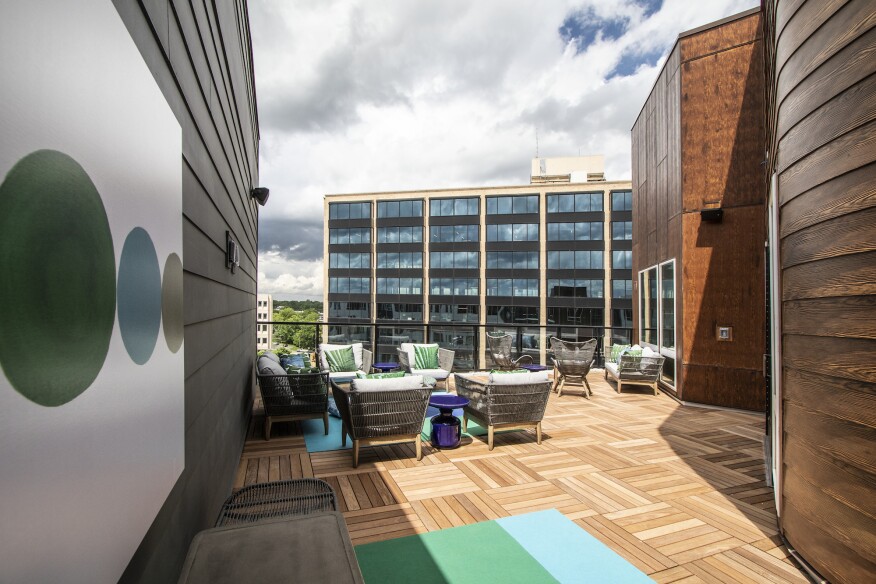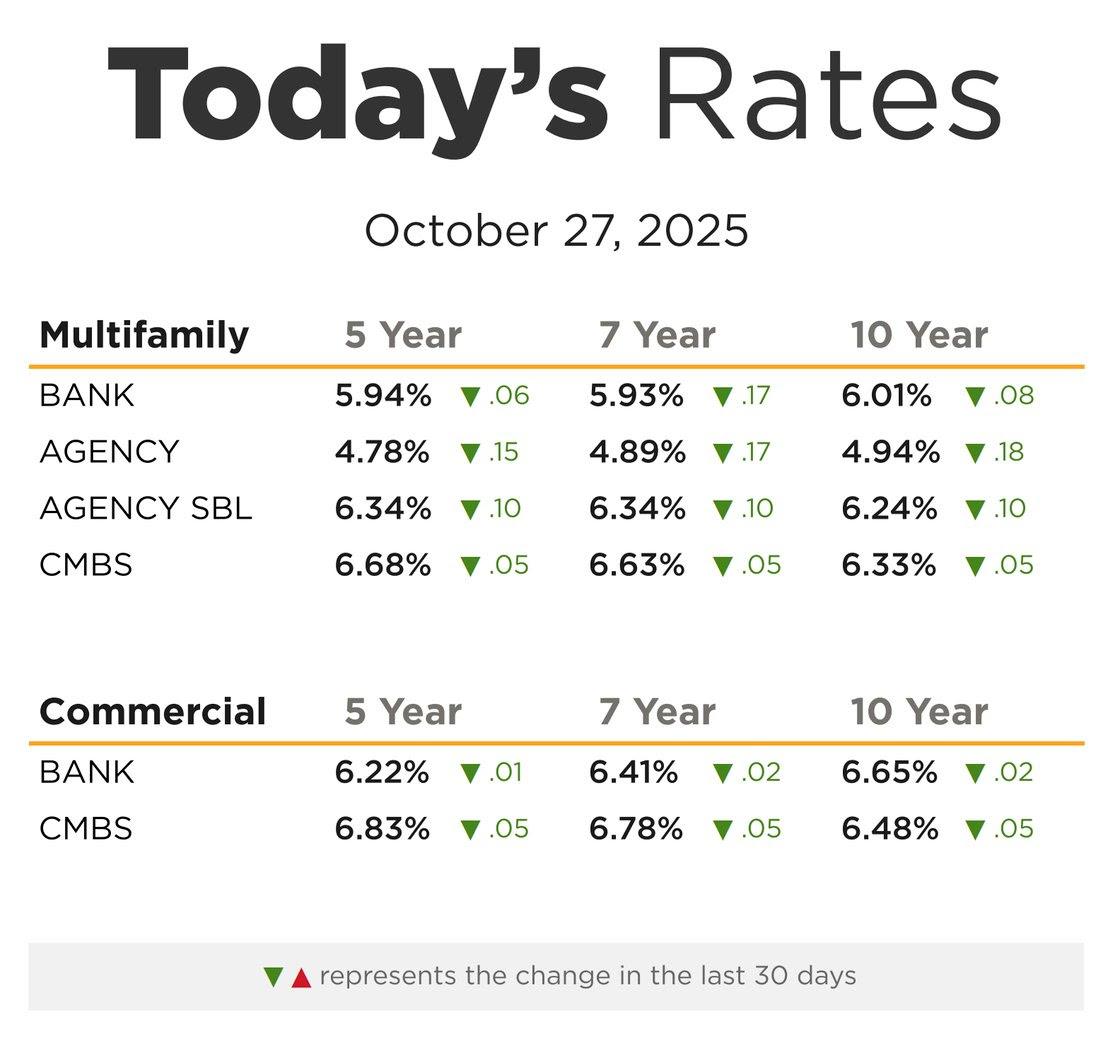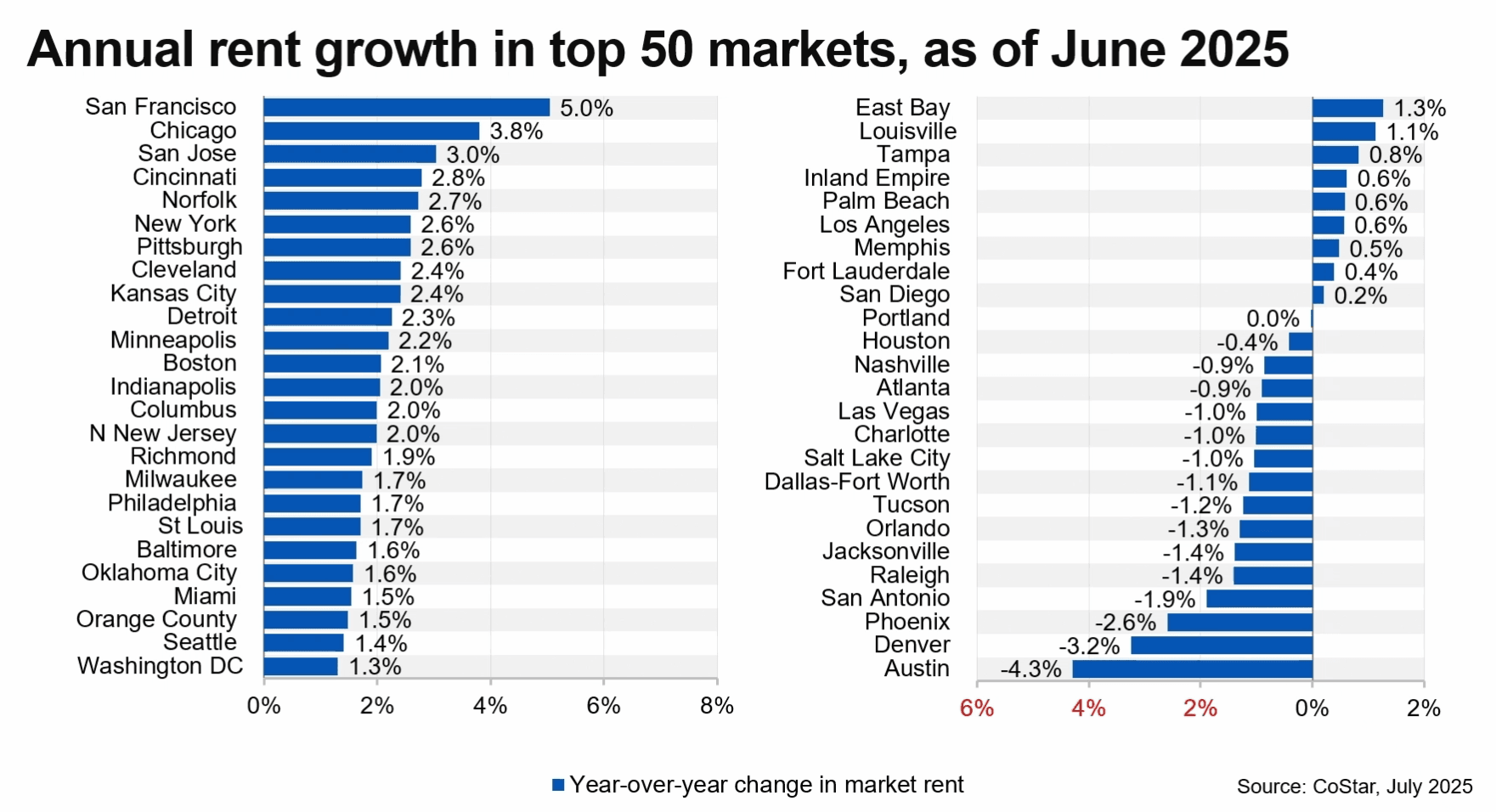When it comes to navigating multifamily real estate investments through a global pandemic, life in the suburbs has been pretty good. Of the two dozen development deals that The NRP Group had on the books in January of last year, 23 of them were closed successfully, resulting in a record production year for the Cleveland-based developer of affordable and market-rate housing.
“We started 5,000 units representing roughly $1.4 billion in real estate value, and 60% of that pipeline was in the affordable business, so we do feel blessed and very thankful again that we are a diversified company,” says NRP principal and president of development Ken Outcalt. “And we’re bullish on both sides of the business going forward. Our past experience of not getting aggressive in high-density urban deals has benefited the portfolio, and we don’t have any of those urban deals right now. We are 100% suburban.”
To be sure, 2020 was not without its challenges. The onset of the pandemic and related shelter-in-place orders in March and April resulted in a virtual freeze on apartment investment and development activity as debt providers vanished, equity players sat on cash, and contractors temporarily shuttered job sites. But despite a hard stop on buying and building in the second quarter, most multifamily firms report a rebound across the second half of the year and are buoyed by stability in underlying business fundamentals and capital markets that portend a thriving rental sector for 2021.
Like NRP, Charlotte, North Carolina-based Crescent Communities headed into the year with high expectations and the deal flow to match. “Obviously we were at the height of the real estate cycle,” says Crescent senior vice president and chief investment officer Jason LaBonte. ”Everyone was flush with cash, the fundamentals were phenomenal, and our pipeline was strong. We do roughly 10 deals a year, and we were out looking to capitalize the 10th for 2020 when the pandemic hit.”
Although six of those development deals were paused due to pandemic-related capital market pricing issues and two deals had joint-venture partners that ultimately walked, Crescent was expected to close out 2020 with all 10 deals intact.
“A lot of equity partners simply needed some insight into what the future was going to look like, and we all needed to get further into this and realize that people still needed a place to live and that Class A multifamily would be impacted less by the job losses,” LaBonte says. “The JV partners are back in the game, and we’ve replaced the ones who walked, so we’ll get all of our deals done for the year.”
Investors, developers, owners, and operators across virtually all multifamily asset classes report similar positive business fundamentals headed into 2021. At Philadelphia-based student housing company Campus Apartments, executive vice president and chief operating officer Miles Orth say occupancies and performance have remained relatively strong across a portfolio of assets serving 50-plus universities and colleges in 18 states.
“That’s not to say that there was not significant disruption,” Orth says. “Operators had to pivot quickly and address new issues and concerns while remaining laser-focused on supporting their teams. But now that we’re nine months into the pandemic, student housing occupancies and collection rates are among the highest in the real estate industry and are clearly demonstrating that this sector is strong, stable, and vibrant.”

Follow the Money
Indeed, strong multifamily asset performance during the pandemic while other real estate classes have foundered is boosting already high rates of global investment into the apartment sector, catalyzing development and possibly sparking consolidation via the acquisition and disposition of portfolios in 2021.

“There is so much capital out there that is ready to invest into multifamily, and a big reason for that is that until the pandemic is resolved, hotel is uninvestable, office is not for the faint of heart, and retail is dead,” Outcalt says. “So there is a lot of dry powder out there looking for apartment deals because most of the other international options for these investors are really risky.”
Equity already allocated to multifamily investments but forced to the sidelines in the second quarter of 2020 also has rushed back into the market, and lending commitments to the apartment sector made by Fannie Mae and Freddie Mac have admirably filled the momentary void from banks, life companies, and CMBS lenders who are now reentering the market. In November, the Federal Housing Finance Agency announced a combined $140 billion commitment to multifamily for 2021, with 50% of that allocation committed to affordable housing.
“Given the pause in activity, the agencies would have to have had just a rocking and rolling fourth quarter to meet the [2020 allocation of $200 billion],” explains PGIM Real Estate head of agency lending Mike McRoberts. “But the amount of capital still chasing the preferred equity and mezzanine parts of deals is still there, and sellers are seeing close to pre-pandemic pricing, which encourages a lot of cross pools that can tie assets together and go to the agencies to structure a credit facility. We did over $1 billion of that in 2020.”
As operators across a majority of markets report only slightly depressed—if not steady—rent fundamentals, buyer appetite in 2021, absent a force majeure event, will remain robust.
“There is a significant amount of pent-up demand for quality multifamily product in quality locations because of the slowdown from the pandemic. A lot of equity players have to get that capital into play or return it,” explains Kevin Keane, executive vice president, and chief operating officer for the Wellington, Florida-based Bainbridge Cos. “We are certainly looking at 2021 as a portfolio buyer because we have those funds in play with investors who want to make those kinds of purchases.”

Limited Exposure
With asset valuations driven by net operating incomes that are heavily weighted toward rent rolls, it’s remarkable that multifamily pricing has remained steady in the face of epic U.S. unemployment and a national eviction moratorium. While rents have remained fairly flat, operators are yet uncertain whether they’ll face exposure to delinquencies across 2021. Anecdotally, the so-called urban exit of renters who no longer need to be close to core office employers and desire lower population density due to the pandemic seems to be bolstering rather than dragging down apartment fundamentals.
“We had some properties that went into lease-up in spring where leasing velocity was down in the 20s versus 30 to 40 units per month, but we did not have to discount rents,” says Keane. “But we are conservative with our underwriting and in some cases even beat our expectations. We think we are benefiting by migration to the suburbs because we are already here. A lot of competitors are still looking for sites, and we have a healthy pipeline of seven developments slated to close in 2021.”
Healthy development pipelines are keeping builders busy, too, and veteran general contractors say the action is hottest in the suburbs, where the pandemic has accelerated millennial household formation and renters escape the dense urban environments that could increase the risk of exposure to the pandemic. “All of these factors are shifting demand for multifamily housing to the suburbs,” says Richard Lara, president, and CEO of RAAM Construction. “It’s bringing us more business, and we expect to see huge upswings in demand for affordable communities in suburban markets in the next few years.”
Outbound urban population migration could also offer insurance to student housing operators should universities and colleges struggle with lingering pandemic issues. In particular, off-campus, purpose-built student housing in smaller college towns or suburban submarkets could be repurposed to meet market-rate demand.
“We have some properties where we were able to pivot to market-rate given their location and proximity to desirable locations in addition to the university they serve,” Orth says. “Five of our properties benefited from that pivot and were able to stabilize occupancy by reaching out to market-rate renters, but that won’t work in every instance, which is why we’ve accelerated our leasing program for 2021 to encourage early decisions by students in their housing selection for the fall.”
As president of Walker & Dunlop Investment Partners, Sam Isaacson oversees a $1.2 billion commercial real estate portfolio and one of the largest multifamily lending and brokerage shops in the country. While Isaacson agrees that softness in the multifamily market has thus far been limited to the urban core, Class A assets, and could perhaps trigger a larger market shift toward suburban development, he’s unsure if multifamily assets as a whole have yet to prove themselves so bulletproof against the pandemic and its socioeconomic aftershocks.
“Multifamily will not be insulated from millions of people being unemployed and having to change careers,” Isaacson says. “We are taking a risk-off position and taking preferred equity instead of joint-venture last dollar exposure, and are avoiding going 100% on the stack given what is going on. If we are taking last dollar risk, it will be on ground-up construction because the risk-adjusted return is better, and we expect a shift there to more suburban product and even single-family build-for-rent given the migration patterns.”

The Long Haul
That’s not to say that luxury urban core is dead as an asset class. On the contrary, veteran multifamily investors and owners feel that market challenges in 2021 and beyond will help winnow an overcrowded playing field of yield chasers and me-too operators and managers, with firms that can adapt without being reactive championing over their peers.
“It’s still too early to predict if there are going to be defaults beyond San Francisco, New York City, and Chicago luxury, and whether or not there has been a true flight to the suburbs,” says LaBonte. “Yes, urban is depressed right now, but time and again those markets have proved to be resilient, and you will see capital come back to core investments. By 2023 and 2024, you will have some suppressed pipeline coming into most of the market, and as long as you are not going in with a merchant build model and build in an eight- to nine-year hold, there will be great opportunities there.”
Like Lara, Outcalt sees increased opportunity in affordable housing across NRP’s markets, particularly given the perfect storm of migration, millennial household creation, and agency allocations to projects meeting affordability thresholds. Playing into the firm’s diversified model (roughly 60% of the portfolio is affordable), NRP is also having success offering third-party construction services to developers anxious to get communities out of the ground.
“In both property management and construction there has been a real flight to quality, and we have 10 deals in our 2021 pipeline that we’ll be building for third parties,” Outcalt says, adding that NRP isn’t hesitant to take on projects in submarkets where it operates its own assets. “Those are the markets where our sub base is the strongest, and one way or another someone is going to build it, so why not us?”
Politics and the economy, too, will continue to shape multifamily real estate across 2021 and beyond. While drastic changes are not expected to agency caps and allocations, leadership at the FHFA is likely to see an overhaul with the rest of the executive branch, and housing policy, in general, is likely to become more stringent and shift further toward affordability.
“Obviously it’s not just getting at the virus with a viable vaccine and treatment. There is a relief rally in the stock market that can provide higher confidence in your top-line underwriting,” McRoberts says. “Then what is the direction of the recovery, and how quickly can we employ people? The speed of that recovery, the speed of changes to the tax plan, the rent control, and eviction moratorium will all have to settle out.”
Navigating portfolios through those challenges might not be such a bad thing, Isaacson says. “Over the last 10 years, anyone could do well in multi-family, and we expect that 2021 will see a separation of the good from the not so good. A bifurcation in performance is coming that will present new buying and business growth opportunities for top performers.”
Receive Market Insights
Periodic analysis on rents, pricing, cap rates, and transaction activity across Chicago and key suburban markets.



